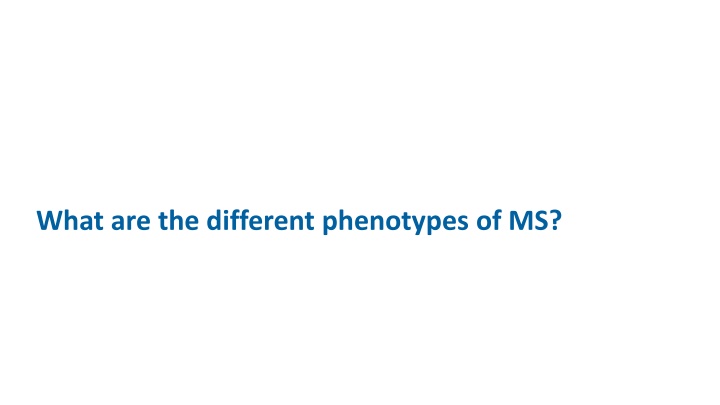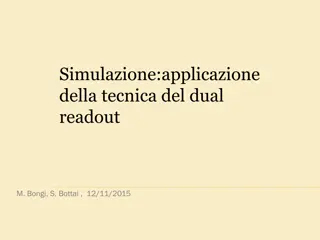
Multiple Sclerosis Phenotypes and Clinical Manifestations
Learn about the different phenotypes of multiple sclerosis (MS) including relapsing and progressive forms, as well as common clinical manifestations such as acute relapses, chronic symptoms, and disability progression. Discover the complexity of MS pathobiology and how patients may experience heterogeneous symptoms and disease courses.
Download Presentation

Please find below an Image/Link to download the presentation.
The content on the website is provided AS IS for your information and personal use only. It may not be sold, licensed, or shared on other websites without obtaining consent from the author. If you encounter any issues during the download, it is possible that the publisher has removed the file from their server.
You are allowed to download the files provided on this website for personal or commercial use, subject to the condition that they are used lawfully. All files are the property of their respective owners.
The content on the website is provided AS IS for your information and personal use only. It may not be sold, licensed, or shared on other websites without obtaining consent from the author.
E N D
Presentation Transcript
MS is a heterogeneous disease, conventionally defined in the clinical setting as either relapsing or progressive phenotypes Based on the natural history of the disease, MS is typically described as having one of four phenotypes: i Relapsing forms of MS (RMS)1,2 Progressive forms of MS1,3 i i i CIS RRMS SPMS PPMS Disability Time Time Time Time MS phenotypes are further subcategorised by disease activity (clinically or by MRI) and are deemed to be either active or non-active CIS, clinically isolated syndrome; PPMS, primary progressive MS; RRMS, relapsing remitting MS; SPMS, secondary progressive MS. 1. Lublin FD, et al. Neurology 2014;83:278 86; 2. National Multiple Sclerosis Society. Relapse-remitting MS (RRMS). http://www.nationalmssociety.org/What-is-MS/Types-of-MS/Relapsing-remitting-MS. Accessed January 2020; 3. National Multiple Sclerosis Society. Primary progressive MS (PPMS). http://www.nationalmssociety.org/What-is-MS/Types-of-MS/Primary-progressive-MS. Accessed January 2020.
MS is characterised by inflammation, degeneration and accumulating disability Peripherally-initiated inflammation dominates in early MS, leading to abnormal lesions and symptom attacks (relapses) Disability Brain volume Later stages are characterised by CNS-compartmentalised inflammatory responses, brain volume loss and neurodegeneration Symptom attacks Disease duration Acute inflammation The complex pathobiology of MS ultimately leads to accumulation of clinical disability Chronic inflammation Secondary neurodegeneration CNS, central nervous system. Figure adapted from Kawachi I, Lassmann H. J Neurol Neurosurg Psychiatry 2017;88:137 45. Bar-Or A. Semin Neurol 2008;28:29 45.
Patients with MS share common clinical manifestations and underlying neuropathological mechanisms of disease Clinically, the symptoms and disease course of MS can manifest in a number of ways1,2 Acute relapses Chronic symptoms Episodes of clinical worsening, which may be followed by complete remission or permanent disability1 Ongoing signs and symptoms, that result from disease progression and adversely impact patients lives Each manifestation can occur to a varying degree in patients, resulting in heterogeneous symptoms and disease courses2 Accumulation of disability and functional worsening may occur following a relapse or independently3 Periods where a patient s MS appears to be clinically non-active (sub-clinically this may not be the case)3 Disability progression Episodes of non-activity 1. Correale J, et al. Brain 2017;140:527 46; 2. Kutzelnigg A, et al. Brain 2005;128:2705 12; 3. Multiple sclerosis: current status and strategies for the future (2001). National Academies Press. https://www.ncbi.nlm.nih.gov/books/NBK222397. Accessed January 2020.
Across phenotypes, MS is defined by continuous disease progression and acute and chronic disease activity1 2 Relapsing Remitting MS (RRMS) Secondary Progressive MS (SPMS) Primary Progressive MS (PPMS) (relapse) (relapse) (relapse) (relapse) Disability Disability Disability (relapse) (relapse) (relapse) Time Time Time Active worsening (active MRI) Active not worsening (active MRI) Not active worsening (active MRI) Not active not worsening Active MRI (relapse or progression) Active with progression (active MRI) Active without progression (active MRI) Not active with progression (active MRI) Not active without progression Active MRI (relapse or progression) Active with progression (active MRI) Active without progression (active MRI) Not active with progression (active MRI) Not active without progression Active MRI (relapse or progression) 1. Lublin FD, Reingold SC. Neurology 1996;46:907 11; 2. Lublin FD, et al. Neurology 2014;83:278 86.
Relapsing-remitting MS typically has an earlier age of onset than PPMS, sex bias and different initial presentation RRMS PPMS ~30 years of age1 ~45 years of age3 Higher incidence in females (3:1 ratio, female to male)1,2 Minimal sex bias1 3* Sensory symptoms predominate, followed by visual symptoms1,4 6 Motor symptoms predominate, followed by sensory symptoms1,4 6 *Although clinical studies have uniformly reinforced a lack of a gender difference in PPMS, a 2017 study of 600 patients with PPMS included in the NARCOMS Registry3suggested the disease could be more prevalent in females. The discrepancy may have arisen from misclassification and selection biases in the registry, mortality rates being higher in males or an inherent bias in clinical trial cohorts.3 NARCOMS, North American Research Committee on Multiple Sclerosis; PPMS, primary progressive MS; RMS, relapsing MS. 1. Rice CM, et al. J Neurol Neurosurg Psychiatry 2013;84:1100 6; 2. Antel J, et al. Acta Neuropathol 2012;123:627 38; 3. Salter A, et al. Mult Scler 2018;24(7):951-962; 4. Cottrell DA, et al. Brain 1999;122:625 39; 5. Sola P, et al. Mult Scler J 2011;17:303 11; 6. Compston A, Coles A. Lancet2008;372:1502 17.
The frequency any type of presenting symptoms differs between patients with RRMS and PPMS Presenting symptoms of patients PPMS1,3 Presenting symptoms of patients with RRMS*1,2 Usually present with sensory symptoms related to a single organ class May have resolved by the time the patient is seen Usually present with a progressive gait disorder Symptoms often predate referral to a neurologist by a number of years 3% 1% 3% 4% 4% 1% 6% Sensory loss Optic neuritis Weakness Paresthesias Diplopia Ataxia Vertigo Paroxysmal attacks Bladder Lhermitte Pain Spastic paraparesis Cerebellar dysfunction Hemiplegia Brain stem syndromes Visual loss Cognitive decline 1% 37% 6% 11% 15% 8% 36% 83% 24% 35% *Incomplete list; symptoms reported in 2% of patients are not shown. PPMS, primary progressive multiple sclerosis; RRMS, relapsing remitting multiple sclerosis. 1. Palace J. J Neurol Neurosurg Psychiatry 2001;7:ii3 ii8; 2. Hauser SL, Goodin DS (2008) in Fauci A, et al (Eds.). Harrison s principles of internal medicine (17th Edition, Volume II). McGraw Hill Medical; 3. Antel J, et al. Acta Neuropathol 2012;123:627 38.
Disability progression is faster in patients with PPMS compared with RMS Kaplan Meier curve for time to EDSS 41 Fast-forward 1.00 Further information on EDSS can be found in module 1.6 Probability of not reaching EDSS of 4 0.75 These curves are not age adjusted - patients with RRMS are typically diagnosed at a younger age, during which time they are better able to compensate against the effects of demyelination and neurodegeneration, in turn delaying disability progression.2 This is in contrast to their PPMS counterparts, who are often included in such analyses at an older age3 0.50 p<0.0001 0.25 PPMS (n=45) RMS (RRMS [n=69] and SPMS [n=35]) 0.00 0 24 48 72 96 120 144 168 192 216 240 264 288 312 Time from diagnosis (months) Curves are not age adjusted. EDSS, Expanded Disability Status Scale; PPMS, primary progressive MS; RMS, relapsing-onset MS; RRMS, relapsing-remitting MS; SPMS, secondary progressive MS. 1. Sola P, et al. Mult Scler 2011;17:303 11; 2. Musella A, et al. Frontiers Aging Neurosci. 2018;10:238; 3. Salter A, et al. Mult Scler 2018;24(7):951-962..
Patients with PPMS require more assistance with activities of daily living than patients with RRMS Instrumental activities of daily living Activities of daily living 46.1 33.6 Travelling Walking 7.6 4.7 43.4 Shopping 8.1 29.1 Grooming 38.6 2.7 Cooking 6.4 25.3 30.7 Bed transfers Cleaning 5.1 1.6 17.8 Finances 24.1 4 Toilet use 1.8 14.6 Taking medication 2.8 7.4 4.1 Eating Communication 0.4 RRMS PPMS RRMS PPMS 0.9 0 10 20 30 40 50 0 10 20 30 40 Patients requiring assistance (%) Patients requiring assistance (%) p<0.001 for all RRMS vs PPMS comparisons. PPMS, primary progressive MS; RRMS, relapsing-remitting MS. Wu N, et al. Presented at ECTRIMS 2017(Poster EP1427).
Overall, progressive MS has greater impact on patients and their caregivers than relapsing MS Compared with patients with RRMS, patients with PPMS or SPMS: Feel more hopeless and resigned about the future2 Are less able to walk1,2 Are more likely to require time off work, or stop working completely1,2 Need more help with daily activities1,2 PPMS, primary progressive MS; RRMS, relapsing-remitting MS; SPMS, secondary progressive MS. 1. Gross HJ, Watson C. Neuropsychiatr Dis Treat 2017;13:1349 57; 2. Holland NJ, et al. Int J MS Care 2011;13:65 74.
Whilst clinical presentation and disease burden of RRMS and PPMS are distinct, there is little evidence that they differ in aetiology or pathogenesis Up to 10% of patients with PPMS experience relapses, supporting common disease mechanisms 1,2 RRMS and PPMS are not easily distinguishable based on the following:2 CSF banding Visual evoked potentials Genetics Neuropathology Clinical features (not distinct from SPMS) RRMS and PPMS should be viewed as two ends of a continuum or spectrum1,2 Fast-forward Further information on assessments like visual evoked potential can be found module 1.6 Clinical Trial Outcomes and Endpoints CSF, cerebrospinal fluid; PPMS, primary progressive MS; RRMS, relapsing-remitting MS; SPMS, secondary progressive MS. 1. Antel J, et al. Acta Neuropathol 2012;123:627 38; 2. Rice CM, et al. J Neurol Neurosurg Psychiatry 2013;84:1100 6.
The average time from MS diagnosis to death is shorter in patients with PPMS than in patients with RMS However Age at death is similar in RMS and PPMS due to later age of onset of PPMS1 4 Time to death from onset of progression does not differ between PPMS vs SPMS1 PPMS vs RMS Kaplan Meier survival curves2 1.0 1.0 0.8 0.8 Cumulative survival Cumulative survival 0.6 0.6 RMS RMS RMS: 49.7 yrs (95% CI 47.7, 51.5) RMS: 76.9 yrs (95% CI 75.6, 78.2) 0.4 0.4 PPMS PPMS PPMS: 32.5 yrs (95% CI 29.3, 35.7) PPMS: 76.3 yrs (95% CI 74.4, 78.3) 0.2 0.2 p<0.001 p=0.9 0.0 0.0 0.0 20.0 Survival from onset (years) 40.0 60.0 0.0 20.0 40.0 60.0 80.0 100.0 Survival from birth (years) PPMS, primary progressive MS; RMS, relapsing MS; SPMS, secondary progressive MS. 1. Scalfari A, et al. Neurology 2013;81:184 92; 2. Kingwell E, et al. J Neurol Neurosurg Psychiatry 2012;83:61 6; 3. Smestad C, et al. Mult Scler 2009;15:1263 70; 4. Antel J, et al. Acta Neuropathol 2012;123:627 38.
What is an MS clinical relapse? Relapses, sometimes called attacks, exacerbations, flares or flare-ups, are acute clinical manifestations of MS disease activity1 3 A relapse presents clinically as an episode of neurological disturbance (such as paraesthesia, weakness/clumsiness or visual disturbance) in the absence of fever or infection, that lasts for at least 24 hours1 3 A clinical relapse is often associated with a trip to the emergency department or a hospital admission3 MS relapses are unpredictable and the relatively sudden onset of neurological symptoms may be functionally and socially incapacitating4,5 A relapse evolves over a few days, plateaus, then remits over a few weeks or months3 Attacks are separated by 30 days from the onset of the first event to the onset of the second.6Relapses may be followed by periods of recovery and be spread over time, or they may occur without full recovery1 1. Thompson AJ, et al. Lancet Neurol 2018;17:162 73; 2. Poser CM, et al. Ann Neurol 1983;13:227-31; 3. Brain Health: Time matters in multiple sclerosis. https://www.msbrainhealth.org/report. Accessed January 2020; 4. Leary SM, et al. Postgrad Med J 2005;81:302 8; 5. Vollmer T. J Neurol Sci 2007;256:S5 S13; 6. McDonald WI, et al. Ann Neurol 2001;50:121 7.
MS relapses are variable, unpredictable and highly disruptive for patients Symptoms of MS (% prevalence in MS)5 8 A relapse presents clinically as an episode of neurological disturbance in the absence of fever or infection, that lasts for at least 24 hours1,2 Cognitive issues ( 50%)5,6 Depression (31%)8 Sensory inc. vision problems (85%)6 The relatively sudden onset of neurological symptoms may be functionally and socially incapacitating3,4 Fatigue (83%5) Pain (54 67%)5,7 A relapse evolves over a few days, plateaus, then remits over a few weeks or months4 Bowel/bladder dysfunction (34%/60%)5 Mobility impairment (90%)5 Sexual dysfunction (31%)5 Relapses may be followed by periods of recovery and be spread over time, or they may occur without full recovery1 Spasms/stiffness (63%)5 Walking difficulty (67%)5 The most common symptoms of MS include fatigue, impaired mobility and sensory disturbances,5,6 but loss of normal neuronal function throughout the CNS can also lead to seizures, sexual dysfunction and speech problems5 CNS, central nervous system. 1. Thompson AJ, et al. Lancet Neurol 2018;17:162 73; 2. Poser CM, et al. Ann Neurol 1983;13:227 31; 3. Vollmer T. J Neurol Sci 2007;256:S5 13; 4. Leary SM, et al. Postgrad Med J 2005;81:302 8. 5. Zwibel HL. Adv Ther 2009;26:1043 57; 6. Kister I, et al. Int J MS Care 2013;15:146 58; 7. Rae Grant AD, et al. Mult Scler 1999:5:179 83; 8. Boeschoten RE, et al. J Neurol Sci. 2017;372:331 41.
Relapses are caused by underlying inflammation of the CNS and resulting demyelination that interferes with nerve conduction Relapses occur when inflammatory demyelinating episodes surpass a clinical threshold1,2 SPMS RRMS Disability CIS Presymptomatic MS Disability Underlying disease progression Clinical threshold Inflammatory demyelinating episodes Time CIS, clinically isolated syndrome; CNS, central nervous system; RRMS, relapsing remitting MS; SPMS, secondary progressive MS. 1. Traboulsee A. J Neurol Sci 2007;256:S19 22; 2. Stys PK, et al. Nat Rev Neurosci 2012;13:507 14.
Acute relapses generally consist of three phases, then patients remain clinically stable until the next relapse Phase 1: Worsening Typically takes several days to reach maximal deficit, but may take hours or minutes or several weeks Phase 3 Phase 2: Stability Disability Phase 3: Recovery Usually within 6 weeks; although can take months Recovery can be: No improvement (4%) Partial Complete Phase 2 Phase 1 Time Multiple sclerosis: current status and strategies for the future (2001). National Academies Press. https://www.ncbi.nlm.nih.gov/books/NBK222397. Accessed January 2020.
Relapses are often associated with an increase in disability Net change in EDSS score from before to after a relapse (mean interval duration 114 days): 42% of patients demonstrated measurable residual worsening after a relapse 100 90 86 42.4% EDSS increase 0.5 points 80 70 Number of patients 60 28.1% EDSS increase 1 point 50 40 33 32 30 20 20 14 8 8 7 10 5 4 3 2 1 1 0 -3.5 -2.5 -2.0 -1.5 Change in EDSS from before to after relapse -1.0 -0.5 0.0 0.5 1.0 1.5 2.0 2.5 3.5 4.0 N=224 EDSS, Expanded Disability Status Scale. Lublin FD, et al. Neurology 2003;61:1528 32.


![Read ebook [PDF] Infiammazione Zero La Promessa Della Dieta Antinfiammatoria](/thumb/9900/read-ebook-pdf-infiammazione-zero-la-promessa-della-dieta-antinfiammatoria.jpg)


















